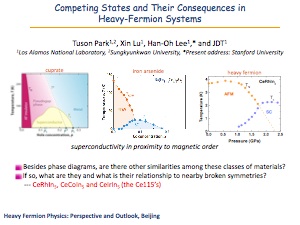Institute of Physics, Chinese Academy of Sciences


Jan 07-09, 2012

Competing States and their Consequences in Heavy-Fermion Systems*
J. D. Thompson
Los Alamos National Laboratory, Los Alamos, NM 87545
Magnetism and unconventional superconductivity are two states found commonly in heavy-fermion materials. Though there are the several examples where both states are induced to coexist by adjusting some non-thermal tuning parameter, the so-called Ce115 systems have proven particularly useful for exploring the relationship between magnetism and superconductivity. Neutron diffraction as well as NMR experiments point to a coupling between order parameters of the broken symmetries and provide evidence for their real-space microscopic coexistence. These conclusions, however, need to be reconciled with simple measurements of resistivity and specific heat that suggest the emergence of some form of electronic texture when both states coexist. As will be discussed, possible evidence for this texture is not limited to the Ce115 systems or to the coexistence of magnetism with superconductivity.
*In collaboration with T. Park and X. Lu. Work at Los Alamos was performed under the auspices of the U.S. DOE, Office of Basic Energy Sciences, Division of Materials Sciences and Engineering.

click the picture to download
contact
Yi-feng Yang, Institute of Physics, Chinese Academy of Sciences, P. O. Box 603, Beijing 100190, China. Tel: (86)-10-82649448, (86)-18911600270; Fax: (86)-10-62553698; Email: yifeng@iphy.ac.cn


